
2022The College of Fine & Applied Arts Magazine
Stay in Touch
Email faa-advancement@illinois.edu with your feedback, updates, and stories.
Do we have your most up-to-date contact information? Don’t miss out on FAA event invitations and news – visit go.illinois.edu/FAAUpdate with your latest email and mailing address.
Editor Amy Karagiannakis
Designer Natalie Fiol (BA ’ 10 LAS)
Copy Editor Anne Jackson
Associate Director of Strategic Communications Mariana Seda (MA ’ 21 Theatre)
Director of Communications
Andy Blacker
Assistant Dean for Advancement Jon Salvani (MS ’ 21 GIES)
Dean Kevin Hamilton
Explore More Online
Visit Dimension.faa.illinois.edu for extended content and even more stories about our faculty, students, donors, and alumni. Scan the QR code now to get more FAA.

Architecture Art & Design
Dance
Japan House
Krannert Art Museum
Krannert Center for the Performing Arts
Landscape Architecture Music
Sustainable Design Theatre
Urban & Regional Planning
ON THE COVER: COMBATING DEFORESTATION BY REPURPOSING FOOD WASTE

Gabe Tavas (FAA ’22) is a biodesigner, explorer, and social entrepreneur from Chicago. Passionate about environmental regeneration, Tavas works at the intersection of nature, design, and community engagement. He serves as the CEO of Symmetry Wood , a startup that creates wood from bacteria without cutting down trees to combat deforestation. Tavas has a long-term interest in helping Chicago become a ‘Fab City’ that locally produces most of its essential products like food, energy, and materials.
Tavas was recently awarded the Fiddler Innovation Fellowship from the National Center for Supercomputing Applications (NCSA) for his development of a sustainable wood alternative called Pyrus™. The work on Pyrus™ started as a side project for Tavas in his dorm room and at the university’s Fab Lab. Now an FAA graduate, Tavas is committed to growing his biotech startup, Symmetry Wood. His team partners with Kombucha production facilities to gather their food waste and then repurpose it to grow bacterial cellulose, which mimics the cellulose found in trees and serves as the main component of Pyrus™.
Gabe Tavas was part of the first cohort of students graduating with their Bachelor of Science in Sustainable Design from the College of Fine and Applied Arts. This program is relatively new to the college but has seen steady growth since its inception in 2018. “In a nutshell, I would say that my experience at the University of Illinois made me more creative, confident, and patient! I got to push myself to new levels in my work and was exposed to a wide selection of the College of Fine and Applied Arts thanks to the sustainable design program. I feel very grateful to have been part of the school and will remember it fondly as I push forward,” said Tavas. ■
Cover image: Gabe Tavas holding a piece of Pyrus™, the sustainable wood alternative. Photo by James Dyson Foundation.
This publication was produced by a local printer certified by the Forest Stewardship Council on recycled paper (70% postconsumer content) and using earth-friendly inks.
Photo by Dylan Murphy.
1 A Thriving Illinois: Higher Education Paths to Equity, Sustainability, and Growth (2021) https://ibhestrategicplan.ibhe.org/ pdf/A_Thriving_Illinois_06-15-21. pdf
2 “CRT Map: efforts to restrict teaching racism and bias have multiplied across the U.S.,” Stout & Wilburn, Chalkbeat, Feb 1, 2022. https://www.chalkbeat. org/22525983/map-critical-racetheory-legislation-teaching-racism
A Message from Dean Kevin Hamilton
efforts last year through enacting a “uniform admission” policy for the University of Illinois (under Public Act 102-0187), which provides automatic admission for transfer students from community colleges who meet certain minimal requirements.
Where educators in at least 36 other states face legislative efforts designed to restrict mere discussion of racism and bias in the classroom, 2 our state’s leaders are not only naming how structural inequities restrict access to education but identifying the address of these matters as central to the state’s success. At Illinois we also have in our chancellor, now in his sixth year, an experienced leader in educational equity, as recognized by his recent addition to the Board of the Directors of Hope Chicago, a new exemplary organization funding college education for scores of disproportionately affected Chicago families.
I write in August of 2022 as a new academic year begins – our third operating in pandemic conditions. Here in FAA, the past summer afforded time to reflect with gratitude on not only the faculty, staff, alumni, and supporters who have helped us through these times, but on the many things that make teaching at a public university in Illinois an ever more distinctive privilege within the landscape of higher education.
Though we have our outstanding faculty to thank for the quality and character of our classes and curricula, we ultimately depend on the state’s highest body, the Board of Higher Education, for guidance on our work and plans. That body’s recent strategic plan rightly describes the thriving of the state as dependent upon closing gaps in access to education “that disproportionally impact African American, Latinx and other students of color, low-income students, working adults, and students from rural communities.” 1 Going forward, the Board will require all new curricular proposals to include explicit plans to address these disparities.
This means that when we make changes to who, how, and what we teach to ensure access and equity here at the University of Illinois, we have an invitation to move with a whole state of educators doing likewise. The governor and legislature strengthened such

Here in FAA, we are emboldened by all of this, even as we know we have much to correct in our college to ensure our part in the work. We see our degree offerings as uniquely suited to not only preparing students to be part of the state’s equity and justice work but also to meeting students where they are in their distinctive passions for creating and sharing. Through our burgeoning Arts Impact Initiative, we are bringing data to back up those convictions and beginning exciting new conversations with partners across multiple sectors to ensure that our graduating artists, designers, architects, planners, scholars, and performers are welcomed by employers who understand exactly what assets they bring.
At a time when families are asking many good questions about the value of education, the record of our alumni and faculty is evidence of the unexpected places that specialization in our fields can take you. As evidenced by the stories in this issue of Dimension, arts vocations testify to an unexpected paradox – that by going deep in the areas of knowledge we steward, people learn to be students all over again in ever new places, disciplines, and conditions. As I encouraged an auditorium of high schoolers gathered at the U.S. Capitol this summer to celebrate their success in the Congressional Art Competition – for artists, specialization is a superpower. May the enclosed stories of unexpected applications of that power embolden you in your support for the arts and in our work together for good. ■
Photo by Fred Zwicky, UI Public Affairs.
3
Rita Bass (BFA ’21) returned to the School of Art and Design as a sculpture major more than 50 years after beginning her degree at the University of Illinois in the late 1960s. After consulting with an academic advisor, she was thrilled to discover that she only needed two courses to graduate, and both could be completed online. She was readmitted into the School of Art and Design and enrolled in the fall 2020 semester – 51 years after making that difficult decision to leave. Upon graduating in May 2021, Bass established the Rita F. Bass Scholarship for Non-Traditional Students. This scholarship is available to students who either went directly into the work force out of high school and later decided to pursue a higher education degree, or students who started college and had to drop out before completing their degree program. “If I can go back after 50 years, and graduate, others who have been out of school for far less time can too.” Bass is hopeful that this scholarship provides the support someone might need to take that next step.
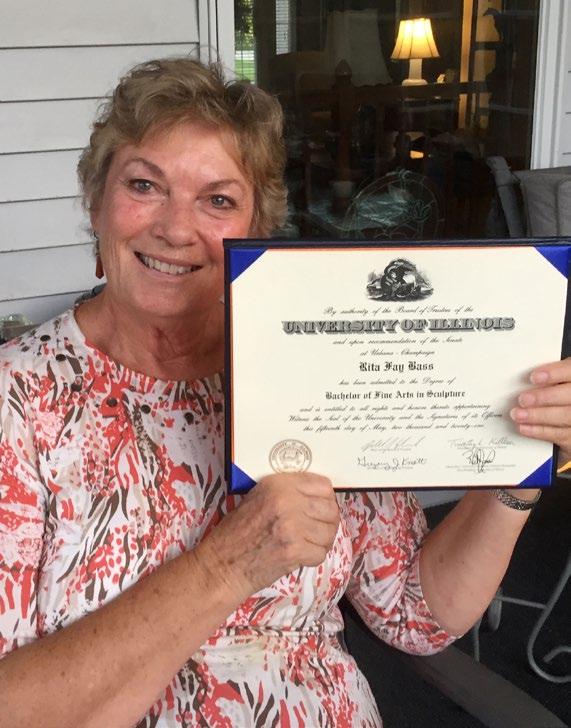
Read the full story at go.illinois.edu/rita-bassscholarship
■
Difficult to see. Always in motion is the future.
By Amy Karagiannakis
If you asked Paul Zinnes in 1977 what he wanted to do when he grew up, he probably would have told you, “I want to make Star Wars.” At age 11, that sounded like a pretty cool job after seeing the blockbuster movie in theaters, but what did that mean, and how do you get involved in something like that? It took many years and four important life-changing decisions later before Zinnes fulfilled his childhood dream of making Star Wars.

Paul Zinnes, director of digital assets for Lucasfilm Animation, grew up in Champaign and attended University Laboratory High School. Zinnes was a few years into his undergraduate education in chemistry at the University of Illinois when he realized that he wasn’t really enjoying it, and he couldn’t picture a rewarding career in front of him if he continued down that path. It was the late 1980s, and at a time when technology was advancing
rapidly, the industrial design field was very attractive. He managed to take some industrial design courses at the School of Art and Design during his senior year, and after graduation, he enrolled in the Industrial Design master’s program.
While attending graduate school, Zinnes worked as a graduate assistant for campus recreation. Shortly after completing his degree, he accepted a more professional position with the university which afforded him the opportunity to take courses for free. With the release of groundbreaking movies like Jurassic Park and Terminator 2 at that time, Zinnes became very interested in computer graphics and wondered what it would take to get into that field. It was at this moment when he made the first decision that played a critical role in his career path. There was an artistfacing computer graphics course, taught by School of Art and Design Professor
RITA BASS
GRADUATING 50 YEARS AFTER SHE STARTED, RITA BASS IS PAVING THE WAY FOR OTHER NON-TRADITIONAL STUDENTS
Paul Zinnes (BA ‘88 LAS, MFA ‘91).
Donna Cox, that was very selective. In fact, students were required to interview with Professor Cox before enrolling. Zinnes recalled, “I was standing on the steps of the Art and Design Building that day, trying to decide if I should just go back to my office across the street to get some work done or make the effort to get to Donna’s class at the Beckman Institute. I decided to go. That night, I got a call from Donna, and she said, ‘You’re in.’ That was it.”
It was this class, and the experience he gained from working in the computer lab with Professor Cox, that ultimately launched Zinnes into the field of computer graphics. The technology and facilities on campus were the very same programs being used at big studios which allowed him to gain valuable skills that ultimately prepared him for a career in this new field. Fast forward to the second significant decision in Paul Zinnes’s career.
In 1995, he decided to submit a few frames of animation that he had been working on to the juried computer animation festival at SIGGRAPH, the annual conference on computer graphics. After a few months had passed and well after he stopped working on the project, Zinnes was notified by the organizers that he had been selected to present at SIGGRAPH. He worked day and night, spending countless hours in the lab with the support of Donna Cox and her team, to render frames and finish the animation project. The completed animation was shown at the festival and immediately opened up many opportunities to interview at some of the most prominent computer animation studios in the world. Zinnes had several interviews lined up at SIGGRAPH, including Industrial Light & Magic (ILM) and Pixar. However, it was a
small poster with a stormtrooper on it that said, “LucasArts wants you,” that really captured Zinnes’s interest. He considered applying but knew that he would have to take a taxi across town to drop off his demo reel. Ultimately, he made that third critical decision to give it a shot. Before the day was over, he got a call to interview with LucasArts, and though they were interested, they just didn’t have a position for him at that time. A few days later he was offered a job with Cyan, the creators of Myst, which at the time was the best-selling PC game on the market. When Zinnes let LucasArts know that he was offered a job, they immediately flew him out to San Francisco to meet with them. After the interview, LucasArts invited him to lunch at Skywalker Ranch, which Zinnes described, “We sat down, and after a little while, I noticed George Lucas walk in and sit down for lunch across the room. I said, ‘Okay I’m in. Sign me up.’”
Paul Zinnes worked on a number of LucasArts video games in the five years he was with the company, and it was that fourth major life decision to accept their job offer over Cyan that allowed him to build this network within the Star Wars franchise. His favorite Star Wars project would come about many years later when he was recruited to Lucasfilm to work on the animated series The Clone Wars. This was one of the last Star Wars projects George Lucas directly worked on. Lucas decided to build a team from scratch that could fulfill his vision to create an episodic CGI animated Star Wars television series. Zinnes was one of the core members of this team assembled at Skywalker Ranch in Marin County, CA. They met with George Lucas on a regular basis as they worked through creating what Lucasfilm referred
to as “the next generation of the Star Wars saga.”
“I had absolutely NO idea how incredibly consequential those four decisions would be. For each of them, I could have just as easily made the opposite choice, which would likely have meant I would not be where I am now. It’s so important to make those extra efforts when the opportunities arise,” Zinnes shared. Now with over 25 years of experience in video games, feature film visual effects, and episodic broadcast animation, Paul Zinnes can legitimately say, I make Star Wars. He doesn’t though, because he’s incredibly humble and credits the many creatives he works with nationally and internationally each day to bring fans what they love. Zinnes explained, “It’s really a team effort. I’m like the general contractor for our shows. We have a design department with incredibly talented concept artists that create a blueprint of sorts for the characters, environments, props, and vehicles. I get all of these drawings for what the spaceships should look like, what the planets should look like. It’s up to me then to figure out, how do I build this?” As to what’s next in that galaxy far, far away, Zinnes says he’s looking forward to the upcoming release of season 2 of The Bad Batch, which he says, “represents some of the team’s finest work and storytelling.” Beyond that, Zinnes remains tight-lipped other than to say, “we always look to amaze, surprise, and entertain our fans.” ■
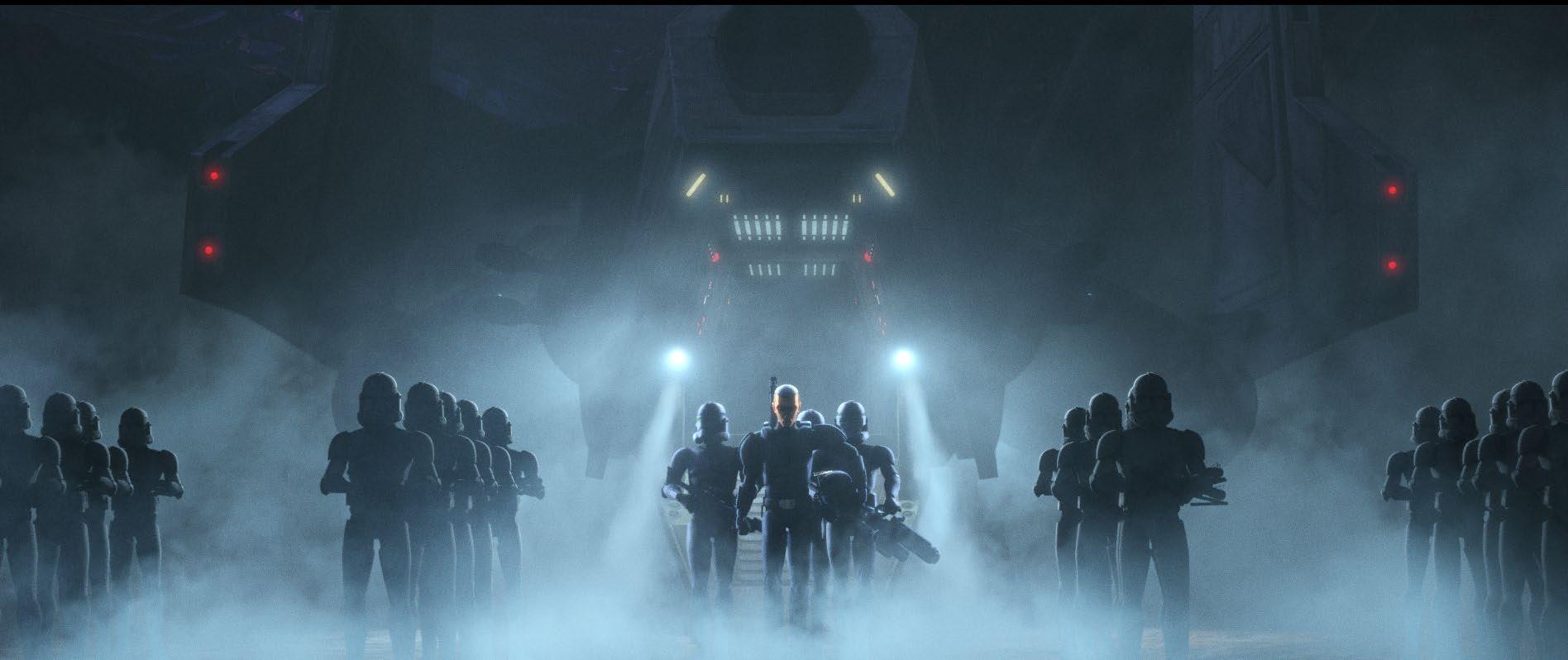 Scene from The Bad Batch
Scene from The Bad Batch
5
In Memoriam:
Fishman
By Amy L. Powell, Curator of Modern and Contemporary Art, Krannert Art Museum
Krannert Art Museum mourned the passing of Louise Fishman, an artist whose unwavering commitments to both abstraction and feminism will continue to thrive through her work. Fishman was a process-driven painter whose canvases often matched the reach of her arms, showing evidence of scrapers, trowels, and other materials that she applied to add texture or transfer wet paint away from the surface. Fishman’s devotion to such physical ways of working and her many references to literature, music, and queer life were inseparable from her efforts to transcend society’s restrictions on her various identities: Jewish, lesbian, feminist. Her work and life provide a model for an affirming practice and for making kinship among those one loves.
Following her undergraduate training at the Tyler School of Art in her birth city of Philadelphia, Fishman in her words, “headed west” to the University of Illinois Urbana-Champaign, where she earned an MFA in painting and printmaking in 1965. The School of Art and Design honored Fishman with a distinguished alumni award in 2019. Her return to campus included a memorable lecture, MFA studio visits, and a reunion with Blonde Ambition (1995), a stellar canvas the Krannert Art Museum acquired early that year.

Fishman’s painterly obsessions were highly varied and deeply passionate. She was equally interested in such objects as Duccio’s twelfth century Maestà, Paul Cézanne’s bathers, scholars’ rocks from China, the expressiveness of paintings by Franz Kline or Chaim Soutine, and Titian’s works she visited during frequent sojourns in Venice with her wife Ingrid Nyeboe. Her attachments also included the artists Agnes Martin and Eva Hesse, whom Fishman knew and memorialized in a small drawing in the Jewish Museum’s collection.
In her 1977 essay “How I Do It: Cautionary Advice from a Lesbian Painter,” in the journal Heresies, Fishman wrote about influence:
Try not to cut whole bodies of work out of your vision unless you’ve looked at them and studied them thoroughly: don’t stop looking at El Greco because he’s not Jewish, or Chardin because he’s not an abstract painter or Matisse because he’s not a lesbian. By all means look at Agnes Martin and Georgia O’Keefe and Eva Hesse. But don’t forget Cézanne, Manet, and Giotto. If good painting is what you want to do, then good painting is what you must look at. Take what you want and leave the dreck.
Krannert Art Museum opened a careerspanning exhibition of Fishman’s works on paper on August 26, 2021, one month from the date of her death. A Question of Emphasis: Louise Fishman Drawing became an unexpected memorial to the artist and to the histories and communities she embraced in her work. The exhibition’s catalogue included full color reproductions, foldouts of Fishman’s leporello (accordionbound) books, and essays by me, artists and scholars Jill H. Casid and Catherine Lord, and a conversation between Fishman and artist Ulrike Müller. Before closing on February 26, 2022, the exhibition earned a national review in Art in America and is now available for purchase through Distributed Art Publishers (D.A.P.).
■
School of Art & Design Distinguished Alumna Louise Fishman with her 1995 painting Blonde Ambition in Emphatic: American Painting from the Collection, installation at Krannert Art Museum, 2019. Photo by Julia Nucci Kelly.
Louise
(1939–2021)
Art through Movement:
By Mariana Seda
As part of their 2022 programming, Krannert Art Museum (KAM) hosted two dance residencies that culminated in immersive live performance experiences. Dance in museums, while not unheard of, introduces visitors to an art form not typically represented in these spaces – a living work made of bodies in motion that cannot be confined to a dated plaque on the wall.

Rebecca Nettl-Fiol, a professor in the Department of Dance, presented Danse Soirée de Bonbons which featured seven dancers performing a series of short works she choreographed over many years. An actor wearing a portable speaker played music, primarily by artist Jacques Brel, and held a sign that read “Follow Moi,” leading the audience through four different galleries as the dances progressed. NettlFiol found that the artworks on display inspired the costumes she ultimately selected for the dancers and even altered the significance of some of the gestures within the pieces. “To have moving art with still art is really special,” said Nettl-Fiol, “one gives meaning to the other, and maybe you see the paintings in a way you wouldn’t see them before.”
As her thesis performance, Kayt MacMaster (MFA ‘22) devised a multimedia immersive dance experience during her one-month residency with KAM. MacMaster’s piece,
hog ranch, hogwash, or putting lipstick on a pig , blended elements of scavenger hunts, burlesque historical re-enactments, and museum audio tours to guide the audience through an exploration of women’s lives during the years of American westward expansion. “I was taking a choreographic look at frontierism, specifically women’s roles on the frontier – women who traveled alone and were entrepreneurial,” said MacMaster. As a storyteller, MacMaster was inspired by both historical accounts, and the self-legendizing tales of women from that time. “To a certain extent this is an area of women’s history and representation that is sometimes lost. So, telling these stories, both the truthful and the legendary, is interesting as a feminist act of resistance in reclaiming erasure.”
Like in Nettl-Fiol’s piece, MacMaster’s work interacted with both the location and the art works. “My character was invented in that space,” she said, “I was sort of a freakshow – a relic of the frontier. And I performed that piece as if I were an artifact in the museum. I wanted it to be in conversation with this place, this institution, the land, and the museum in general.”
Traditionally, dance performance is seen in spaces designated precisely for performance: stages, theaters, large empty rehearsal rooms with wall-length mirrors. Bringing movement into the museum space requires navigating the rules the museum
has in place to protect its collection and works of art on display. “The dance programs that took place at KAM this past year were a way to think through, and hopefully expand on, how we view, interact with, and think about visual art and the collection at Krannert Art Museum,” said Liza Sylvestre, curator of academic programs at KAM. “At this moment in time visual art and museums are increasingly responsible for thinking critically about the histories they enforce and carry forward; this includes how accessible they are and who they are accessible to, their relationship to colonization, and their relationship to, and enforcement of, visual dominance.”
For Krannert Art Museum, experimenting with performance art, specifically dance, in their space is not a novel idea. Dating back to 2013, KAM has hosted a variety of dance performance “exhibits” like OPENSTUDIO 2, a collaboration between dance faculty Cynthia Oliver, David Thomson, and Tere O’Connor. “I see enormous potential for the future of performance at the museum,” said Sylvestre. “It presents the opportunity for cross-unit collaborations and, most excitingly, it supports the creation of new ways of making, thinking about, sharing, and experiencing art.”
■
KAM SETS THE STAGE FOR DANCE
Laura Chiaramonte (MFA ’09) and Rachel Rizzuto (MFA ’21) in Rebecca Nettl-Fiol’s Danse Soiree De Bonbons: On the Rocks
Photo by Natalie Fiol.
7
VOCES BRILLANTES: EMPOWERING COMMUNITY YOUTH THROUGH ART
By Mariana Seda
Krannert Art Museum (KAM) featured a new exhibit that amplified Latina/x girls’ voices through multimedia works. Centering their lived experiences, the exhibit created space for the girls to represent their stories, languages, and cultures in humanizing and empowering ways.
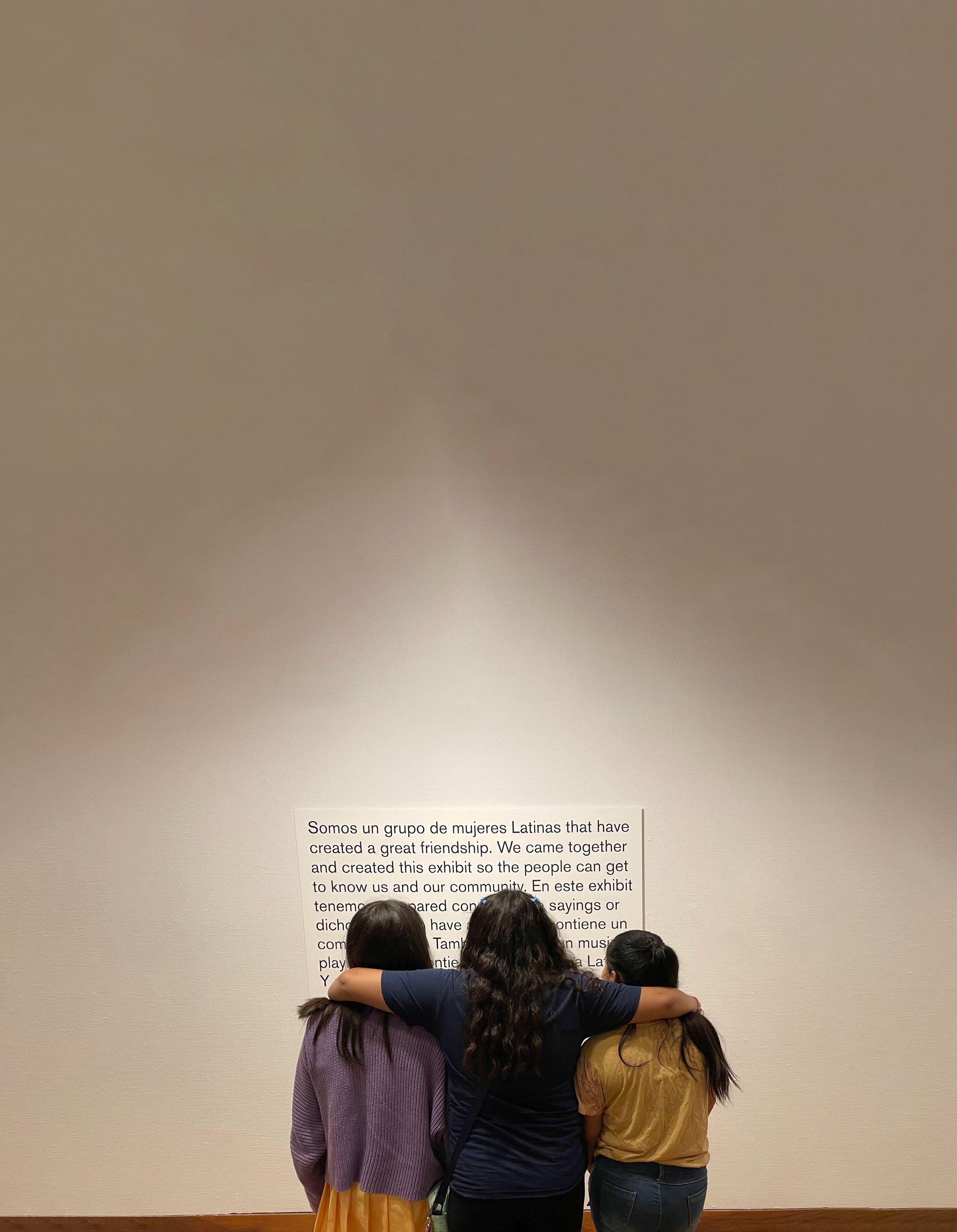
Latina Community ‘Voces’ was on view in the museum’s Hood Gallery, a space that was historically used as a classroom but was transformed into a pop-up exhibit gallery this past year. Idalia Nuñez Cortez, Mónica González Ybarra, and Catherine Dornfeld Tissenbaum, professors with the Department of Curriculum and Instruction, worked with five Latina/x girls from Urbana Middle School to imagine, design, and curate the exhibit. “The idea started with an interest in changing the typical narratives that are presented in museums, which tend to exclude communities of color and youth,” said Nuñez Cortez.
‘Voces’ offered a variety of interactive audio and visual experiences, as well as framed drawings and writings. Presented in huge lettering, the featured text was collaboratively written by the girls in Spanglish – a combination of Spanish, English, and slang. The accompanying labels for each piece were written in both English and Spanish. On the Muro de palabras/Word wall, the artists shared sayings and cultural references that infused their everyday lives. One of the girls highlighted her multilingual heritage by writing the K’iche’ and Kanjobal (indigenous Mayan languages) words for “tortilla” furthering the nuance and complexity of understanding Latina/x identity in our communities.
Other works included a video of a “snack-off” food challenge that the girls hosted and filmed at their school, featuring Flamin’ Hot Cheetos, Doritos, and Valentina hot sauce as ingredients. An interactive map displayed places in Urbana-Champaign that were meaningful to the artists, whether it was a favorite restaurant, a place of recreation like a skating rink, or the grocery stores where their families shop.
Perhaps the most visceral part of the exhibit was the Lista de canciones/Playlist, a list of songs selected by the artists that represent the soundscape of their lives. Songs ranged decades and genres featuring artists from Selena to Doja Cat. The playlist was interactive and accessible, allowing visitors to sit down, scroll the list, skip a song, or go back to a favorite to hear it again. Since the music played through the gallery speakers, it enveloped the space, heightening not only the experience of the other works but also an awareness of connecting with the other visitors, noticing who was singing along or dancing.
For KAM visitors, Latina Community ‘Voces’ provided opportunities to build crosscultural understandings, relationships, and solidarity
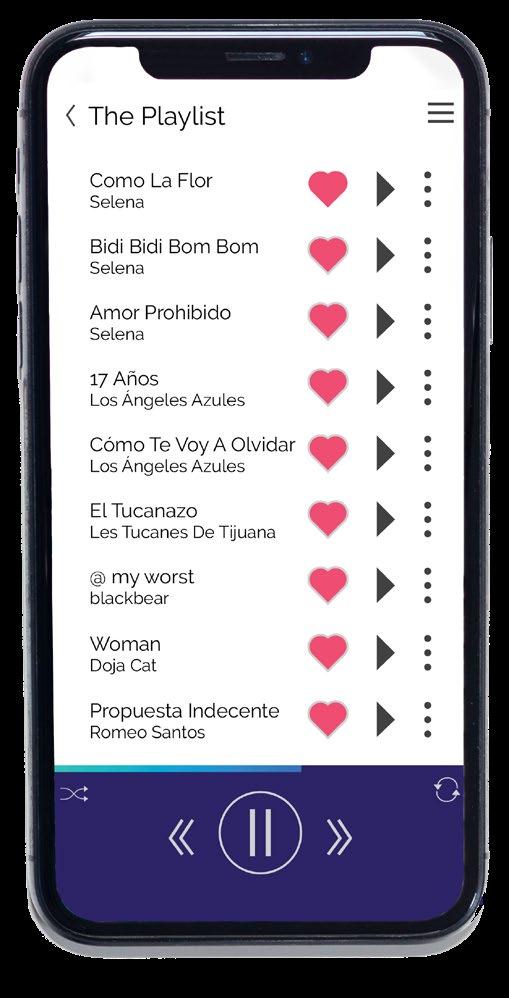
with Latina/x girls. By the exhibit’s close, the response wall had filled up with messages, drawings, affirmations, and notes of gratitude for the artists and their work.
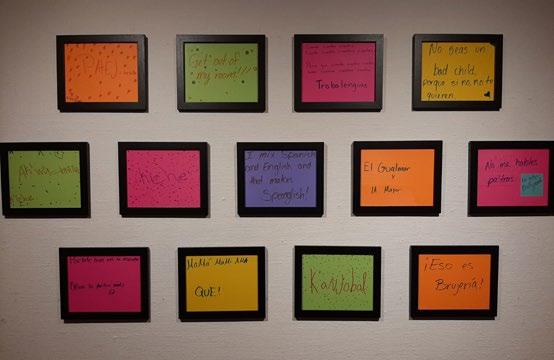

When the artists first visited the exhibit, there were joyful exclamations of appreciation. “It’s so amazing to see this work up,” said one of the girls, “like, stuff I made and stuff my friends made stood out to people. And to be Latina and be special...that means a lot.”
Another girl delighted in the playlist. “I picked this song!” she exclaimed. “I can’t believe we got our artwork in a museum. That’s a really hard thing to do. We worked so hard.”
Each artist had a different piece that resonated most with them. But when it came to their favorite part of the process, the response was unanimous: teamwork and connection. “We spent a lot of time together just talking about our lives, and I loved that.”
Kamila Glowacki, interim manager of education for KAM, and Ishita Dharap, education coordinator, helped coordinate and install the exhibit which received funding through the Call to Action to Address Racism & Social Injustice Research Program . “We are very excited for the future potential of continuing this work with the museum and the community,” said Glowacki. “This was an exciting pilot year and we’re grateful to have the opportunity to keep expanding.”
Latina Community ‘Voces’ was cocreated in partnership with Girls Go for It! (GGFI), the College of Education, and Krannert Art Museum. The exhibit was on view in the Hood Gallery from April 12, 2022, to July 9, 2022. ■
Photo by Mónica González Ybarra.
The Department of Dance is implementing its redesigned curriculum this semester. As someone who played a pivotal role in the development of these changes, what do you hope to accomplish in this first year?
I am hoping there will be a lot of excitement around these changes. A top priority is cultivating more collaboration and a sense of community. We also really want our students to be fully engaged in the diversity of dance styles now being offered in intensive formats. The new curriculum provides deep immersion in rigorous experiences that challenge students physically and intellectually, while opening their eyes about the cultural, political, and economic contexts in which these dance styles emerge.
During Jan Erkert’s 16-year tenure as department head, she made significant changes to the department resulting in a substantial increase in the diversity of faculty and the student body. As the new head, how do you plan to build upon these efforts?

I believe the new curriculum is a direct outgrowth of the substantive increase in diversity of our faculty and student body. Jan was always concerned about expanding ideas about who dances, where we dance, and why we dance. Our new curriculum directly engages in these questions, and we have new faculty members that add to our diversity both in terms of race and identity and aesthetics. My goal will be to keep making recruitment of diverse faculty and students number one. We can never be complacent. And, there is no such thing as being too diverse.
What are your top priorities as head?
I see my top priorities as mentoring new faculty and making sure the new curriculum is put into place with care. I am also very much interested in expanding our nonmajors program so that our reach extends out into the campus even more. We will be broadening our offerings for nonmajors, and we now also have an undergraduate minor in place. We will also be expanding our online curriculum.
Having choreographed over 50 pieces that have been produced in venues across the U.S., Canada, South America, and Europe, you are no stranger to success in the field of dance. What drew you to teaching?
When I was younger, I saw teaching as an outgrowth of my ambitions as a choreographer. I began teaching so that I had access to studio space! I was also anxious to teach people my ideas about the body and performance that were an outgrowth of my classical modern and somatic training and my aesthetic as a choreographer. As I taught more and more, I learned more and more. My choreography became directly connected to my pedagogy and vice versa. I also developed close relationships with students that I value greatly. Dance is a social art form, and we spend a lot of time together. We learn how to encourage and nurture each other, and that goes both ways between faculty and students. I love how my students challenge me to think in new ways and to dream beyond my own experience.
You have collaborated on numerous works, both in your academic and professional career. How do you choose which projects to take on? Which one are you most proud of?
Collaboration is certainly in my DNA. I often choose projects and people to collaborate with based on friendship and mutual respect. I am very attracted to working with people who I know will challenge me. Collaboration is an education. When you take a deep dive with someone in a creative way, you have the opportunity to learn from their vantage point and to engage in their training and professional histories in an intimate way. It is my favorite way of learning.
As the dance industry continues to break with conventional norms and push the boundaries of what dance can be, how do you think dance education can best keep up as we look to better prepare our graduates?
I do not think of dance in the academic setting as having to “keep up” with the profession. We ARE the profession. All of our faculty are active professionals presenting work all over the world. And our students often engage in that creative research with us and get opportunities to be a part of professional projects. Dance at Illinois has always been a very progressive department and that will continue. So, maybe a better question would be, how is the profession planning on keeping up with Dance at Illinois?
■
HEAD
DEPARTMENT OF DANCE
Photo by Elliot Reza Emadian.
Q & A WITH Sara Hook
OF THE
9
Social Progress Through Design
 By John H. Prince (BLA '25)
By John H. Prince (BLA '25)
Many students come into design school with a very particular image or preconceived notion of what design practice is. The name Frank Lloyd Wright often comes to mind, as well as some of the bigger corporate offices like Gensler and SOM that have ample resources and numerous clients. Professors Aneesha Dharwadker and Conor O’Shea emphasize the importance of focusing in on some of the smaller practices that take into consideration the social impact when selecting projects. In reference to a seminar she teaches on global design practice, Dharwadker said, “We can look at these smaller-scale, more socially-oriented practices in juxtaposition with practices that are more established or more familiar. Then we try to understand what the benefits and drawbacks are of both.”
This concept of design for social impact is not just something that Dharwadker and O’Shea teach, they also practice it. Dharwadker’s Chicago Design Office was founded in 2017 to provide pro-bono design services to community organizations. O’Shea founded Hinterlands Urbanism and Landscape in 2014 to “rethink the contemporary urban realm through the medium of landscape.” Aneesha Dharwadker has joint appointments in both the Department of Landscape Architecture and the School of Architecture at Illinois. Conor O’Shea is an assistant professor with the Department of Landscape Architecture and directs the Landscape Strategies Laboratory on campus. Married in 2017, the couple decided to move both of their practices into a shared space in Chicago’s Ukrainian Village in 2019 – just one of many collaborations.
FirstFollowers is a non-profit based in Champaign that supports the reentry of formerly incarcerated people back into society. In 2017, a generous member of the community donated a home that the non-profit decided to renovate into a shared neighborhood asset that would become the FirstFollowers Learning Lab. The renovations and updates would be completed by the people in the program with the help of design consultants. After speaking with Marlon Mitchell, the executive director of FirstFollowers, Dharwadker shared, “The FirstFollowers Learning Lab aligned very well with a lot of my interests, including how architecture can have a positive impact.” It was rather early on in discussions that Aneesha Dharwadker realized that there were both architecture and landscape architecture components involved, and so she invited O’Shea to join the project. The two have served as design consultants over the last few years and have provided several drawings and renovation plans that stemmed from conversations with the people the project was designed to help. O’Shea explained, “We are there to facilitate the creation of ideas. We held a design workshop with the folks that would be renovating and using the space to generate conversations and develop plans. This is a key element of the assistance we provide.” Construction on the Learning Lab began in 2018 and is an ongoing project that uses design-build principles to teach carpentry, residential construction, and landscape skills to formerly incarcerated people in the Urbana-Champaign community. Dharwadker added, “The renovations and improvements that are made to the building are part of the pedagogy.”
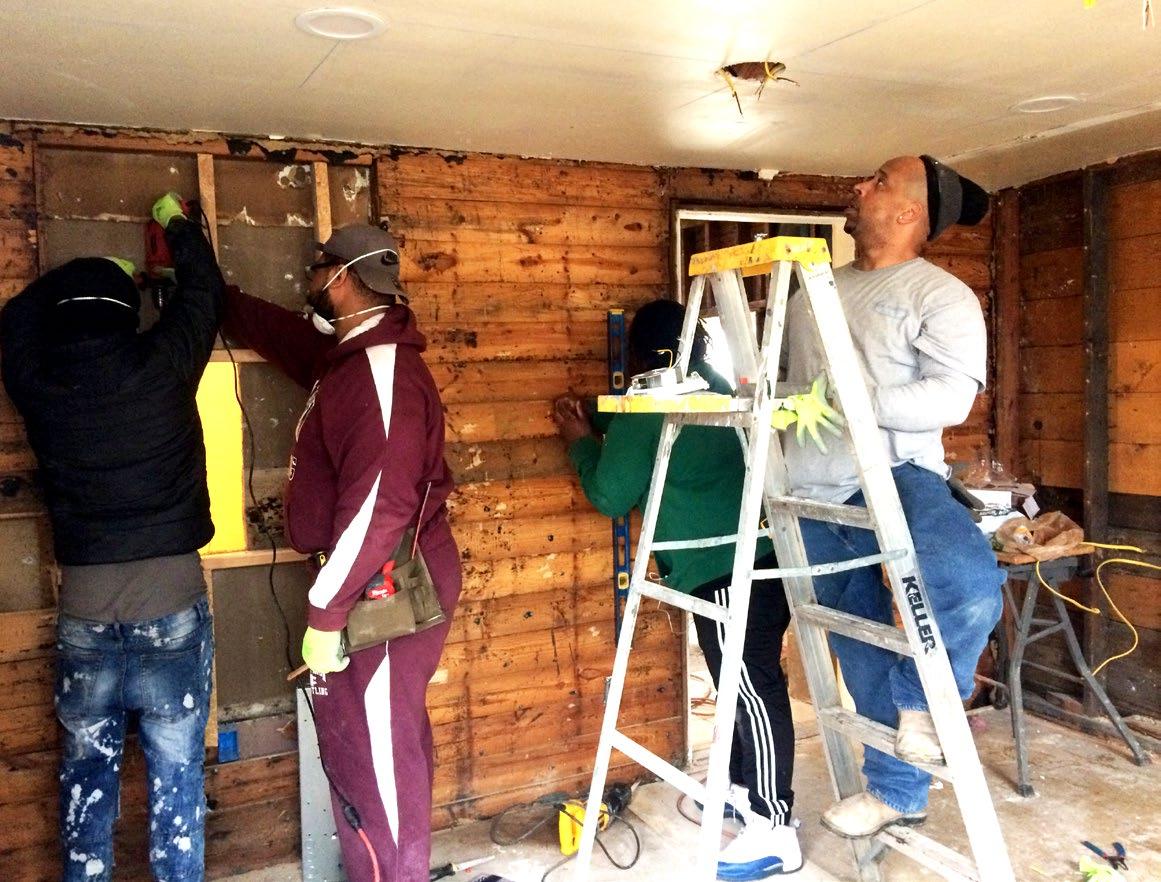
The FirstFollowers Learning Lab is an ongoing project – people come through the program, contribute to the renovation, and then reassimilate into society with their newfound skill sets. Since this program started, FirstFollowers has bid on other construction projects in the community based on consultation and designs provided by Dharwadker. Professors Dharwadker and O’Shea continue to explore how design can make positive social impacts in relation to the built environment through their research and philanthropic work.
■
The Department of Landscape Architecture announced the establishment of the new James Martin Family Scholarship in Landscape Architecture last spring during their annual Sasaki Day celebrations. Alumnus and longtime friend and donor of the department, Jim Martin hopes the scholarship will benefit students who have a strong interest and passion for the field of landscape design. Martin graduated from Illinois in 1972 and is celebrating 50 years in the landscape architecture profession this year. Through his company, James Martin Associates, Inc., he has supported over 50 scholarships for landscape students, community members, and family members of his employees since he founded the Chicagoland company in 1977. Martin previously established the Terry Harkness Plants in Design Endowed Fund in honor of his lifelong friend, favorite professor, and mentor. This year, the department awarded Jim Martin the 2022 Alumni Medal, an honor bestowed on alumni whose lifetime achievements and contributions to the profession have had a unique and lasting impact on the welfare of the public, the environment, and the department.
Read the full story at go.illinois.edu/jim-martin
 JIM MARTIN
PROMINENT CHICAGO REGION LANDSCAPE ARCHITECT ALUM ESTABLISHES NEW SCHOLARSHIP
JIM MARTIN
PROMINENT CHICAGO REGION LANDSCAPE ARCHITECT ALUM ESTABLISHES NEW SCHOLARSHIP
. ■
MAPPING THE ARTS: THE ROLE OF
IN COMMUNITY VIBRANCY AND WELLNESS
By Mariana Seda
Arts can be a powerful agent for community change. Through creative placemaking, communities partner with artists to integrate arts-based practices into community development efforts. This approach fosters connection across sectors to improve physical and economic health, social justice, and wellbeing. As more communities adopt creative placemaking strategies, urban planners are reimagining how to collect, interpret, and share data to help transform communities.
To better understand the contributions of arts and artists within a community, Urban and Regional Planning professors Jennifer Novak-Leonard and Andrew Greenlee and doctoral student Emma Walters (MUP ‘21) are leading a project that aims to showcase the vibrancy and diversity of local arts and cultural communities. With funding from an Extension Collaboration Grant, the Central Illinois’ Cultural Assets: Mapping Resources, People and Meaning to Propel Community and Economic Vitality project will also lead to research-informed community-based products (like maps and videos) and will serve as a model for other communities to adapt.
pilot research program that translates data and research about art and artists into actionable strategies to transform both arts practice and policy.
“We started to think about how we might be able to look at some communities within Illinois to understand the health and vibrancy of art and artists, while also taking into consideration the effects of the pandemic, and the potential role artists play in economic recovery,” said NovakLeonard. “How do you bring different social science and research methodologies to these topics, and how do you translate what you’re learning not only for scholarly outlets but also to bring about change in policy and in professional practices?”
The project team selected Peoria, IL, as their pilot city. “We know Chicago is a huge area on the national stage for arts and culture,” said Greenlee, “but creative activity is everywhere, and Peoria is a locus for that work.” It also helps that there are dedicated local partners for this work, including Jenn Gordon (BMUS ʼ03), the executive director for ArtsPartners of Central Illinois, a nonprofit organization focused on expanding community engagement with the arts through partnerships and promotional programs.
Greenlee’s expertise in community development planning led the group to consider varied and inclusive data collection methods. In addition to federal and local data from sources like the U.S. Census Bureau and City of Peoria, the project is using a video interview and focus group process that engages many stakeholders within Peoria’s arts ecosystem. This comprehensive approach aims to heighten people’s awareness of the diversity within the local arts and cultural community and identify new ways artists can collaborate, coordinate, and evolve.
Novak-Leonard, who joined FAA in 2020, researches the social roles of arts, artists, and creativity and specializes in developing new measurement systems to understand cultural participation. She was particularly interested in bringing together areas of expertise across the college to help launch the work of the Arts Impact Initiative, a
“We didn’t want to assume that there is one monolithic arts community, or one perspective on the assets or resources that can dominate our process,” Greenlee said. “We are designing a research process that is not passive – it’s an active, iterative
process that is designed to have ripple effects and create connections that weren’t there before with the hope that it creates transformations within the community itself.”
Ultimately, the project will lead to a website featuring maps, videos, and other research products that seek to tell the stories of creative spaces and people in Peoria. “Our community partners want an accessible platform where they can access the information and resources that come from this research,” explained Greenlee. They also plan to create a shareable toolkit explaining the methodology and processes used in this project so that other communities can apply them in their own efforts to map, connect, and grow public participation in the arts.
The team hopes that the types of practice happening within the Arts Impact Initiative and its offshoots builds a strong foundation in innovative thinking for the next generation of practitioners in community planning, arts policy, and governance. “We want to create more tools and strategies for understanding the role of arts and creativity in community change, local economies, and wellness of place,” said Novak-Leonard, “and translating that knowledge into actionable insights for developing policy and new ways of bridging gaps within communities.”
■
Artwork featured includes the Hello Peoria mural, created by art students at Bradley University led by Heather Brammeier, artist and professor, and Easterseals Rainbow by Heather Brammeier.


Photos by Andrew Greenlee.
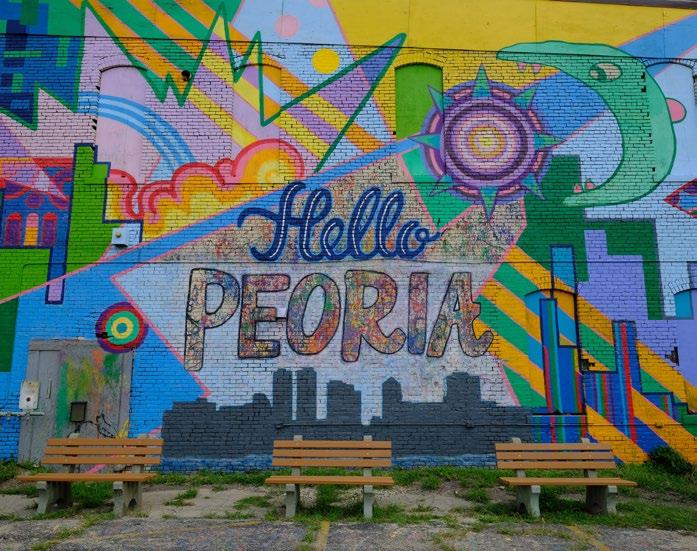
11
Increasing Access to the Arts, One Sponsorship at a Time
By Amy Karagiannakis
Krannert Center for the Performing Arts was established over 50 years ago through the generosity of arts advocates Herman and Ellnora Krannert. Krannert Center continues to nourish creativity and passion – finding innovative ways to strengthen and enrich our community through the performing arts. This would not be possible without the commitment and ingenuity of passionate community members like Susan and Michael Haney. The Krannerts inspired a vision for the future of the performing arts at the University of Illinois, and it is friends like the Haneys that keep that dream alive and thriving.
Michael Haney, an alumnus of the Grainger College of Engineering, returned to the University of Illinois for graduate school in 1977. Susan transferred to the College of Liberal Arts and Sciences and then the Gies College of Business from Western Illinois University as an undergraduate in 1979. Being from a small farm town in Illinois, Susan was enthralled with the art and culture that UrbanaChampaign offered. The two of them met through mutual friends while Susan was still attending school. Susan ran into her friend Pat at the Champaign Public Library who invited her to see the new Star Wars movie with her, her husband Allan, and a friend of Allan’s. That friend was Michael, and the two hit it off. They have been married for 33 years and still remain close with the two friends who introduced them. Michael worked as an engineer and lecturer at the University of Illinois for nearly 30 years, retiring in 2010, and continued to lecture for two more years. Susan is an avid volunteer in the community. She has served as the liturgical artist for the Wesley United Methodist Church for close to 30 years. As a professor of Ikenobo Ikebana, the Japanese art of arranging flowers, she decorates the church and creates flower arrangements for the holidays. She also serves as treasurer for the church’s food pantry and chairs fundraising efforts for much-needed infrastructure updates. Susan also served two consecutive years as president of The Illinois Club, formerly the Women’s Club at the University of

Illinois Urbana-Champaign, and still volunteers with them today. It was her love and mastery of Ikebana that led to one of the couple’s first donations to the university in support of the construction of the current Japan House located in the University Arboretum.
It may come as a surprise that most of the Haneys’ philanthropic support over the last couple decades has not been designated to the University of Illinois colleges that they graduated from. The Haneys recognize the exceptional value of experiences that only the performing arts and cultural centers can provide. Since the Haneys made their very first gift to Krannert Center in 2010, they’ve sponsored close to 40 performances. They understand that the impact of sponsorship goes beyond a particular performance or experience. Michael added, “The first performance we sponsored was Black Watch, a battalion of Scottish bagpipers, which set the stage for us sponsoring international artists that would not generally attract other big-ticket donors.” Giving to the arts in this way ensures a culturally diverse spectrum of visiting artists while also fostering greater access to the arts for area youth and the community. With the establishment of the Susan and Michael Haney Fund for Young Audiences in 2019 and their support of the Krannert Center Youth Series, they continue to advocate for these endeavors. Susan shared, “In sponsoring artists, we are often able to meet them, and in our conversations with these artists and teachers, we have heard how critical our support of young audiences is. And we have witnessed children experiencing the arts and becoming transfixed by what they are seeing and doing during interactive programs.”
The Haneys have also established funds in their name in support of Lyric Theatre at Illinois and Illinois Theatre that can be used to support productions as well as student scholarships. The first Lyric Theatre performance they sponsored was Don Giovanni in which they were allowed to sit in on a rehearsal. This experience
Photo by Becky Ponder.
led to their interest in sponsoring other student performances. Susan and Michael first sponsored an Illinois Theatre production in 2018 and now sponsor two Theatre productions a year. Student performances produced by Illinois Theatre and Lyric Theatre have not traditionally been sponsored by patrons, so the Haneys have been true pioneers in the way the College of Fine and Applied Arts has approached its fundraising efforts. Susan and Michael continue to offer their guidance and unique perspective on fundraising as part of the Krannert Center Advancement Council, a passionate group of people that serve as advocates and ambassadors for Krannert Center.
The two have established a scholarship in the School of Social Work, and they recently committed a $100,000 gift to the Illinois School of Social Work Student Support Fund. They also have established a STEM Education scholarship with the College of Liberal Arts and
Sciences and have contributed to the Lincoln Scholars Initiative, resulting in room 1024 of Lincoln Hall being named after them. In memory of Susan’s cousin who was a Vietnam veteran, they have established a fund for the Chez Veterans Center to support veterans with dependents. When asked how they decide where to direct their gifts, Michael said, “The recurring theme for almost all of our philanthropy is on behalf of the students. As long as this is directly helping students, then that’s what I’m looking to support.” Susan added, “It’s not just about supporting a future Broadway or movie star. The productions that Lyric Theatre and Illinois Theatre produce are so well done. They are thought-provoking and give you a different perspective. Art transports you out of yourself so that you can experience something through someone else’s eyes and hopefully become a more thoughtful and compassionate person by getting beyond your own experiences.” ■
The College of Fine and Applied Arts is incredibly grateful for the partnership of Susan and Michael Haney. In addition to their generous donations of time, performance sponsorship, and unrestricted gifts to Krannert Center for the Performing Arts, they have also provided support in numerous ways for Illinois Theatre, Lyric Theatre at Illinois, Krannert Art Museum, and Japan House. If you’d like to learn more about how you can turn your passion for the arts into impactful scholarships, experiences that inspire, or nurturing youth series performances, please contact the Krannert Center Advancement Office at 217-333-6700 or advancement@krannertcenter.illinois.edu .
Krannert Center Community Reunited with the Return of ELLNORA
By Sean Kutzko, Assistant Communications Director, Krannert Center

Krannert Center welcomed the return of public, in-person audiences in spectacular style with the 2021 ELLNORA guitar festival. After over a year of disruptions due to the pandemic, the festival featured its hallmark level and diversity of artistry but on a smaller scale, prioritizing health considerations for audience members, staff, and artists. There was a palpable sense of joy as artists and attendees alike came together for the communal experience of creating and enjoying music. You never miss your water until your well runs dry, the old blues lyric goes, and every person who was there remembers how
good it felt to drink from the well again. “It was like running through the grass with bare feet on the first warm day of spring after a long winter,” one attendee recalled. “There was a connection between the artists and us in the audience that was awe-inspiring. It felt so good to be back in Krannert Center and experience that again.”
James Quisenberry, a member of the Urbana City Council and long-time Krannert Center donor, expressed similar feelings. “Krannert Center has been a place of joy and rejuvenation for my wife, Jill, and I for many years, and ELLNORA
has been a regular touch point since it began in 2005. The culmination of a return to life for us was the Joan Jett performance where the Tryon Festival Theatre was full again of people enjoying music together.”
The experience was an exercise in re-gathering – centering community health and safety while maintaining standards of excellence expected from an established tradition like ELLNORA. Krannert Center is a showcase of local and national talent – an important part of our community that lives at the intersection of arts education and cultural meeting place. As we welcome audiences for our 2022–2023 season, we continue to explore and formulate new ways to gather moving forward. We can’t wait to see you again. ■
Photo by Fred Zwicky, UI Public Affairs.
13
I-L-L
M IS FOR MUSIC
By Amy Karagiannakis
From section leader of the Marching Illini drumline to vocal music director for Sesame Street, Paul Rudolph (BS ’89 Music Education) has taken some unexpected yet impactful detours along his career journey. Each project, gig, and job he took along the way has played an important role in his success. As Rudolph described, “It was a long and winding road to Sesame Street, for sure.” Now a three-time Emmy award-winning music editor and two-time Emmy-nominated vocal music director, Paul Rudolph is always making music. That passion for creating and composing started at a young age and grew stronger during Rudolph’s time at the University of Illinois.


Rudolph’s first official venture into composition took place in junior high school when he wrote his first marching percussion cadence titled “Paradiddle Cadence.” After seeing the Marching Illini perform while he was in high school, Rudolph knew he wanted to attend UIUC and play in that band. Although Rudolph’s focus in college was music education, his passion for percussion and composition was fueled by the support of inspiring people like Gary Smith, former director of the Marching Illini. It was not unusual, under the leadership of Smith, for students to write drills to be performed at major events. Rudolph was excited to get that opportunity in 1987 as an undergraduate when Smith paired him with an engineering student to co-write a drill that would conclude with the Rolling Stone’s “Satisfaction” and include a formation of the band’s famous logo. Rudolph recalled, “Gary had a way of giving you a sense of ownership and responsibility to a project, by acknowledging your hard work and determination. That experience co-writing that drill and as section leader of the drumline my senior year really strengthened my leadership skills.”
Shortly after Rudolph graduated with his degree in music education, he landed a job as the assistant band director at MahometSeymour High School in Illinois. Eventually that passion to compose led him to return to the School of Music at Illinois to pursue a graduate education in music composition. It was Professor Scott Wyatt’s experimental music class that first introduced Rudolph to the future of digital audio technology and a field that was rapidly advancing. At the advice of a friend and fellow UIUC alum who worked as an assistant to a film scoring agent, Rudolph decided to leave central Illinois for California and look for work. Rudolph was soon connected with Richard Gibbs, a composer working in LA, who offered him a position as his assistant. It was through this work on The Tracey Ullman Show and various made-for-television movies that Rudolph learned how to edit and score scenes of music. In 1995, Gibbs got a call from The Jim Henson Company to be the music director for what would become the second iteration of The Muppet Show, Muppets Tonight. As the assistant music director and mentee of Gibbs, Rudolph was introduced to the world of Muppets and television production. Most significant about this time in Rudolph’s life – it was on the set of Muppets Tonight where he met his wife Leslie Carrara-Rudolph, who later went on to become Sesame Street’s Abby Cadabby.
Rudolph honed his conducting, composing, and digital audio editing skills while working for the commercial composing team of Trivers/Myers Music from 1997 to 2008. One of Rudolph’s most memorable experiences
during this time in his career was when he conducted Herbie Hancock and Lang Lang for a United Airlines commercial at Capitol Studios , followed by a separate session later that day in which he conducted about 35 members of the Los Angeles Philharmonic. Rudolph credits the connections and friendships that he formed with colleagues on the set of Muppets Tonight for the next big break in his career. With his wife in New York, Rudolph was actively looking for work on the East Coast. He was excited when he got a call from Kevin Clash, the co-executive producer of Sesame Street at the time, who was familiar with Rudolph’s background in arranging music and vocal direction. Clash asked him to prepare a version of “Sing a Song” in any style he wanted. Rudolph did what he described as a “cheesy kind of loungy bossa nova arrangement” of “Sing a Song” that included the vibraphone. A few weeks later he was offered a job on Sesame Street
In the over thirteen years working as the vocal music director on Sesame Street, Paul Rudolph has collaborated with guest artists such as Elvis Costello, Prince, Bruno Mars, Lin-Manuel Miranda, John Baptiste, and Dave Grohl. He was the vocal music director and vocal arranger for the Swingin’ Sesame Street Celebration live from the Lincoln Center. As the vocal music director of PBS’s Nature Cat, Rudolph works with Saturday Night Live cast members such as Taran Killam, Kate McKinnon, Kenan Thompson, and many more. Despite all these big names, when asked if there was a particular artist in his career that he was nervous or excited to work with, he said – without hesitation –Emilio Delgado. Delgado played Luis, the Fix-it Shop owner on Sesame Street, from 1971 until he passed away in 2022. Rudolph recalled, “I was totally nervous going into my first day on set because Emilio was going to sing and play guitar live.” Delgado would need to pop up in front of the camera to sing the “Cowmonster Pair theme song ” periodically, and because of the comedic timing that was necessary to pull off the scene, they didn’t want to pre-record it. Because the lyrics in each version were slightly different, Delgado had asked Rudolph to stand next to the camera and lip sync the lyrics along with him. Rudolph remembered thinking, “Luis the Fix-it Shop guy needs my help ! I was nervous enough just to be working with such a show legend, but now, to help him, I need to get the timing just right. It worked out great, but that was day one for me on set.”
Paul Rudolph, while acknowledging that it is “absolutely a dream to work on Sesame Street,” continues to look forward to new projects and opportunities that challenge him, while also making time for himself. He added, “Finding a musical passion outside of your daily routine, something that inspires
you to create and practice, is so important.”
For Rudolph, that passion is his vibraphone and percussion ensemble GLANK, which he formed in 2002. GLANK is a percussion group that uses found object instruments and recycled materials to make music.
“An old heat sink taken from a computer is a musical instrument to me. Or even something as basic as an old aluminum ice cube tray,” shared Rudolph. It was Rudolph’s final School of Music composition recital in April 1995, in which he used the Krannert Center garage as an instrument of echo for a piece called “GLANK,” which later led to the founding of his ensemble. Rudolph’s success and happiness may be the result of many twists and turns, but he says one aspect has remained constant, “Make time and space for music in your life and build on what inspired you early on.”
■
THE SCHOOL OF MUSIC CELEBRATES
125 YEARS AND LOOKS TO THE FUTURE
By Jeffrey Sposato, School of Music Director

During the last weekend of April, the School of Music celebrated its 125th anniversary by doing what we do best – making great music.
Audiences got their choice of ten concerts, ranging from jazz and lyric theatre to choral, orchestral, and band music. And of course, there was birthday cake! It was a joyous weekend in which students, parents, faculty, staff, alumni, donors, and our faithful audiences came together to celebrate the school’s illustrious past and to look forward to what the future holds.
Read the full story at go.illinois.edu/music-125 ■
15
In Singing Praise of Collaborative Research
By Mariana Seda
Singers have known for millennia that the acoustics of a performance space can affect how they perform. Until recently, however, this understanding has been primarily anecdotal.
Yvonne Redman, faculty for Voice Performance at the School of Music, and a long-time main stage soprano at the Metropolitan Opera, was curious about the lack of research on how room acoustics can influence a singer’s voice production.
Like most musicians, vocalists sometimes rehearse in basements, bedrooms, even storage closets – spaces that differ greatly from performance venues. “Oftentimes, performers rehearse in these odd places and become accustomed to their sound perceptions and level of vocal effort,” explained Redman, “but when they are in a new space (often a larger performance space) then they may feel the need to adjust their performance. Most research on how musicians adjust to their environment focuses on instrumentalists. So, our question was: how might a vocalist shift their performance?”
To explore this question, Redman teamed up with Dr. Pasquale Bottalico, a professor of speech and hearing sciences at the College of Applied Health Sciences, and Dr. Joshua Glasner, professor of speech and language pathology at Delaware Valley University. Dr. Bottalico’s expertise stems not only from his study of acoustics and sound measurement but also from his training as an opera singer. Likewise, Dr. Glasner holds a PhD in Vocal Performance.
“Typically the acoustics of a theater is assessed considering the pattern between the stage and different locations in the audience,” explained Dr. Bottalico. Thanks to new technology and an innovative approach, “we were able to quantify the acoustic pattern between the mouth and the ears of a person on the stage.”

Focusing primarily on vibrato (a subtle pulsing of pitch) and intonation (pitch accuracy), the research team developed a study that could measure the variance of these key elements of singing by recording live singers in different spaces.
To conduct this comparative study with as much precision as possible, several singers need to perform in a variety of professional venues within a short time frame – a feat that requires travel, space coordination, and much expense. Unless, of course, they work on a campus like the U of I that is home to multiple world-renowned facilities within walking distance of each other.
Leveraging the unique stages at the Krannert Center for the Performing Arts and Smith Memorial Hall, the research team recorded nine singers in five different performance spaces during the span of one evening. “This is truly an Illinois study, because here at this university we were able to develop a research project that is not only unique but is very special to our campus,” said Redman. “It highlights our incredible performance spaces that we are very proud of.”
After analyzing the recordings, the researchers learned that singers do accommodate their performance somewhat based on the levels of reverberation feedback in a space. Generally, if singers could hear themselves well (higher reverberation) they demonstrated better pitch accuracy and produced slower vibrato. In spaces with less reverberation, singers sped up vibrato and sang louder, both indications of more vocal effort.

So how can these findings help singers train and improve performance? For one, this research can help design performance spaces by considering the acoustic preferences of singers. “This is all a very new and unique perspective. Most acousticians use studies that focus on audience perception to design spaces, but
very little is known about the performer’s perspective,” said Redman.
From a teaching perspective, instructors can use this information to explain to students what they may be able to expect from a space, how to be aware of its influence, and perhaps how to avoid changing their physical delivery based on the changes they perceive.
“Singing is a physical activity. It is really muscular training like any other athletic training – you just can’t see it as obviously as a track star,” said Redman. “If you go to each new space and your perception is radically changed, your production may be different than in practice, and your effort levels may rise and/or your tuning may change. It’s related to exercise physiology training.”
Now that the research team has quantitative evidence supporting their initial question – room acoustics can influence voice production – they want to see how that compares with singer perception. Currently, the team is collecting results for a qualitative study in which they interviewed the singers about their experiences and preferences in regard to each space.
The project exemplifies how fine and applied arts can collaborate with the sciences. “The beauty of a collaborative research project is that I can participate in a project that informs my field without needing to obtain a degree in hearing science or acoustics,” explained Redman. “I can just collaborate with experts, many on our own campus, who can then translate these findings both for my field and their own fields.”
The study, “Singing in different performance spaces: The effect of room acoustics on vibrato and pitch inaccuracy,” is published in The Journal of Acoustical Society of America ■
Photo by Michelle Hassel, UI Public Affairs.
Reimagining Arts Training Through National Research
 By Mariana Seda
By Mariana Seda
What becomes of arts alumni? That is the question that ultimately launched the Strategic National Arts Alumni Project (SNAAP), an ongoing research enterprise that collects, analyzes, and reports on survey data from arts and design graduates from across the United States.
For over a decade, SNAAP data and reports have explored alumni perspectives on their livelihoods and educational experiences. This research has helped higher education and other arts training institutions improve student experiences and transform curricula for better alumni outcomes.
The University of Illinois UrbanaChampaign is a sponsoring institution for SNAAP, with a research team housed within the College of Fine and Applied Arts under the Arts Impact Initiative. Jennifer Novak-Leonard, professor of Urban and Regional Planning, serves as SNAAP’s Research Director as well as the Vice President of the SNAAP Board of Directors. She is also one of the primary preparers for the most recent SNAAP report, Data, Pressing Needs, and Biggest Challenges: Insights from the Field
For this report, SNAAP surveyed scholars and higher education professionals to gain a better understanding of the challenges and opportunities for administrators, institutions, and researchers in their efforts to improve student and alumni experiences. Some of the key findings indicate areas of improvement like expanding equity and inclusion considerations beyond race and gender, by including disability, sexual orientation, and other intersectionalities, and addressing the lack of diverse representation in both faculty and Eurocentric curricula. Additionally, technology and economics emerge as key focus areas for arts and design
training. Institutions must adapt to the ever-evolving technological landscape and prepare their students to navigate creative economies. Another finding points to a need to redefine what “success” means for graduates. This could mean looking beyond just employment and income to other indicators of success like happiness, satisfaction, and positive contributions to community. The report also emphasizes the importance of valuing career paths unrelated to a particular degree. Incorporating these findings into program development efforts could greatly impact the success of future graduates and the programs themselves.
The next major SNAAP survey takes place this fall, and a segment of U of I alumni will participate. With FAA faculty at the helm of this research, our college will be among the first to glimpse the new data and begin to analyze and even take action on the valuable findings.

“The SNAAP survey is not only key to our improving student experience, but also offers a way to build on this university’s distinctive platform to advance imagination and action nationally with regard to who seeks an arts-based education and to what ends,” said Kevin Hamilton, dean of FAA. “I’m excited to see what supporting the SNAAP survey will offer us in the way of making evidence-based cases for how arts vocations change lives and what people need to thrive in them.”
Read the full story at go.illinois.edu/arts-alumni ■
 OLD GHOST (w/ artist) Kendall Hill (BFA ‘19 New Media)
OLD GHOST (w/ artist) Kendall Hill (BFA ‘19 New Media)
17
Dean’s Excellence Scholarship Fund


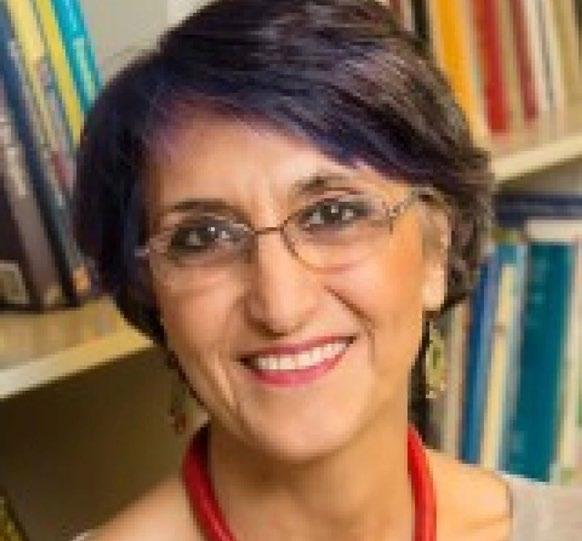
FAA to Establish New Dean’s Excellence Scholarship
The College of Fine and Applied Arts (FAA) is establishing The Dean’s Excellence Scholarship Fund to ensure that all bright and talented first-year students are able to enroll and thrive in the college’s undergraduate programs. This scholarship will provide financial support for excellent students, prioritizing those from historically underserved communities and racial and ethnic groups.
Giving to the Dean’s Excellence Scholarship Fund provides a direct and immediate impact for an incoming first-year student who may be struggling with their college decision based on financial constraints. Economic background should not be the deciding factor for students who demonstrate academic and creative excellence. The support of our alumni and friends through the Dean’s Excellence Scholarship Fund will allow the college to educate and prepare the best students to become the next artists, designers, architects, scholars, teachers, and planners that will go on to creatively address the world’s challenges.
Are you ready to invest in the future of the arts and help FAA attract and retain the best students? Contact Assistant Dean for Advancement Jon Salvani at faa-advancement@illinois.edu or 217-333-1660 to learn more about how you can support the Dean’s Excellence Scholarship Fund.
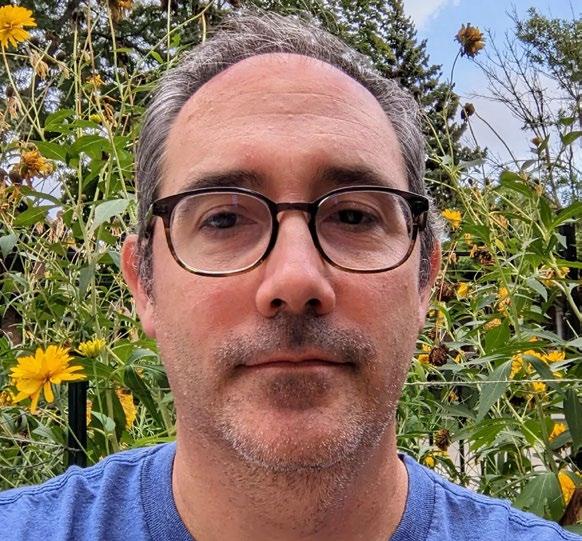
Faculty Awards and Recognition
Liza Sylvestre, curator of academic programs at Krannert Art Museum, was selected as one of 15 inaugural recipients of the new Joan Mitchell Fellowship for painters and sculptors. The fellowship provides a total of $60,000 in unrestricted funds to the artist across a five-year timeline allowing them to allocate the money in a way that best develops their work and career. In her role, Sylvestre is responsible for connecting the university’s faculty and students to the museum –developing KAM into a vital teaching resource across all disciplines at the University of Illinois. She is known for her intersectional and multidisciplinary work that explores the ways in which our senses alter our experience and perception of the world. Sylvestre’s work as a multimedia artist has been shown both nationally and internationally.

Alan Mette , professor and director of the School of Art and Design, was one of four University of Illinois UrbanaChampaign faculty honored with the 2022 Campus Awards for Excellence in Faculty Leadership. Mette received the Executive Officer Distinguished Leadership Award which recognizes outstanding academic leadership and vision by an executive officer within a college or campus unit. Under his leadership, the School of Art and Design has seen an increase in public engagement and significant achievements in undergraduate recruitment and retention. The Office of the Provost sponsors the campus-level awards in recognition of faculty members who distinguish themselves in their vision of the future and their efforts to enable and promote others in shaping that future.
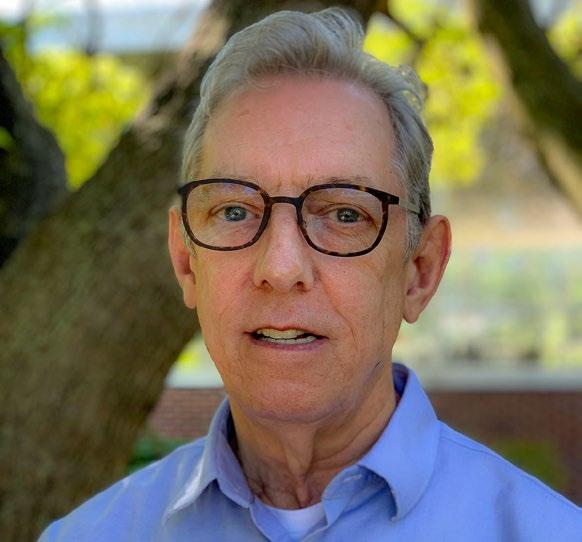
Faranak Miraftab, professor of Urban and Regional Planning, and Ryan Griffis , associate professor of New Media, collaborated with visiting artist Nasrin Navab on the exhibition “Reckless Law, Shameless Order.” The exhibit, which explored the shared experiences of people held in confinement and displayed works by formerly incarcerated artists, was on view at Krannert Art Museum from February 11–April 2, 2022. The collaborations that this exhibition fostered led to art-based workshops and intimate dialogues in which these artists found common practices of punishment and experiences across ethnicities, cultures, and borders. “All of the artists, even though they were put in situations to be crushed and dehumanized, protected their humanity,” Miraftab said. “It’s their humanity that comes through in their art.”
College Excellence Awards
Each year the College of Fine and Applied Arts recognizes outstanding faculty and staff who go above and beyond to make an impact in the lives of our students. Read more about our 2022 College Excellence Award recipients at go.illinois.edu/2022-awardees
Alumni Awards and Recognition
Carol Ross Barney Awarded the Order of Lincoln and Design Leader by Architectural Record
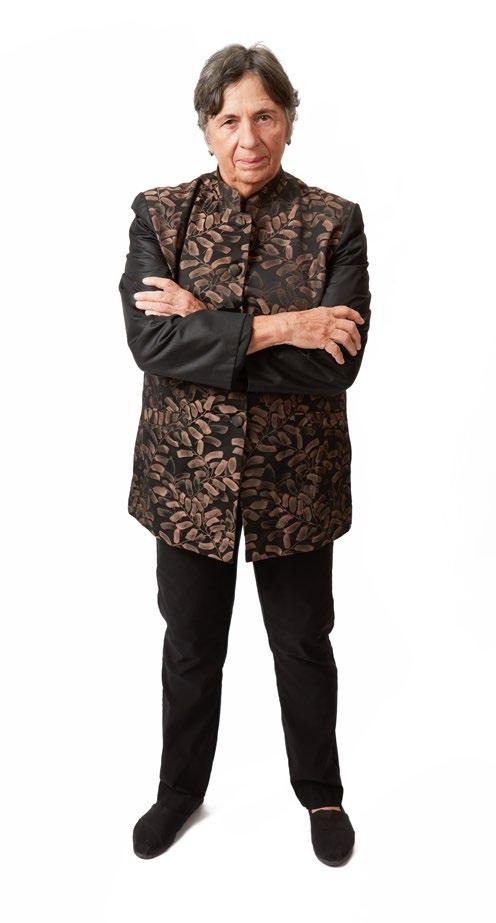
Illinois School of Architecture alumna Carol Ross Barney, FAIA (BArch ‘71), was recognized by Architectural Record with the 2022 Design Leader award. This category in RECORD’s ninth annual Women in Architecture Design Leadership Awards honors women architects with significant built work and influence. This past year, Carol Ross Barney was also honored as a 2021 recipient of the Order of Lincoln, the state’s highest honor for professional achievement and public service. A native of Chicago, she is the founder and principal of Ross Barney Architects and a founding member and first president of Chicago Women of Architecture. Her work has earned her an international reputation in design of institutional and public buildings including the reconstructed Oklahoma City Federal Building, two of Chicago’s most heavily used transit stations at Fullerton and Belmont Avenues, and the Chicago River Walk project. Barney is only the third architect to have received the Order of Lincoln, joining Ludwig Mies van der Rohe and Buckminster Fuller.
Illinois Theatre Forms New Alumni Advisory Board
Illinois Theatre recently announced the inaugural members of their new Theatre Alumni Advisory Board. The board is comprised of alumni that represent the diversity, breadth of careers, and a variety of accomplishments of graduates from the Department of Theatre. The overall mission of the board is to build and maintain a robust alumni engagement program that provides value for alumni, current students, the Department of Theatre, and the broader theatre community. The board serves in an advisory capacity offering input to the department head and the producer of Illinois Theatre. The board also mentors current students, generates human and material resources to help the department produce well-equipped theatre professionals, and advocates to keep Illinois Theatre and theatre arts at the forefront of the campus community and beyond.
Planning at Illinois Launches New Alumni Strategy Council
This past year, the Department of Urban and Regional Planning formed the Alumni Strategy Council (ASC) made up of 16 undergraduate and graduate alumni. These inaugural members, diverse in background, cohort, and workplace, will serve three-year terms. The council will work to reinforce and deepen the department’s commitment to making communities more equitable, inclusive, sustainable, and just. They intend to expand professional development opportunities to current Planning students including internships and practice-oriented course engagement. The council will work to strengthen the department’s connections with alumni, practitioners, and leaders in the fields of urban planning and community development.
Legacy Award 2022 Recipients
DISTINGUISHED LEGACY AWARDS
Anton Armstrong (MM ‘80 Music)
Robert Faust (BFA ‘90 Graphic Design) Mary Anna Pomonis (BFA ‘95 Painting)
EMERGING LEGACY AWARDS
Ryan Murphy (MArch ‘08 Architecture) Wei (Windy) Zhao (PhD ‘15 Architecture)
ILLINOIS ARTS LEGACY AWARDS
Seth Fein George Irwin
Read more about all of our 2022 Legacy Award recipients at faa.illinois.edu/legacy-awards
Join Us in Celebrating the 150 th Anniversary of Architecture’s First Alum
Nathan Ricker, the very first alumnus of the Illinois School of Architecture, was also the first graduate of an architecture program in the United States. This academic year, we are celebrating the 150th anniversary of the nation’s first architecture graduate and the school’s first alumnus with the Ricker 150 fundraising initiative.

Together we are raising funds for scholarships to attract and retain the best students, visiting lecturers to secure top professionals and enrich student learning, optimized design studios, cutting-edge digital fabrication technologies, and experiential learning opportunities at home and abroad. As the Illinois School of Architecture continues to build on its
unique history, we, much like Nathan Ricker, want to solidify the school’s role in the future of architectural education.
Ricker 150 will provide ongoing support to enable the school to push boundaries, redefine creativity, and inspire the next generation of architects to lead within their field. Consider being a part of the historic Ricker 150 fundraising initiative by donating to the Illinois School of Architecture at go.illinois.edu/Ricker150 or by using the QR code. Watch for a special Ricker 150 Day of Giving in May 2023 to celebrate the official anniversary of Ricker’s graduation.

19
Japanese Art and Aesthetics Minor
Japan House is excited to announce that as of this current semester, the new Japanese Arts and Aesthetics minor is now available to students. The minor is ideal for students who wish to develop cross-cultural competency and learn to integrate Japanese aesthetic theory and practice into their broader pursuits. Students will take a variety of courses in traditional and contemporary Japanese arts and aesthetics including topics such as Japanese tea ceremony, anime, design, manga, and much more.
One of the courses available to students is an independent study in Japanese aesthetics. This consists of a directed independent research project or creative
project in which students may have the opportunity to collaborate with visiting artists. Last spring, students learned about apprenticeship in Japanese traditional culture and were visited by Douglas Brooks, an expert in traditional Japanese wooden boat building. During the week of his visit, students worked with Brooks to build a wooden boat at the Siebel Center for Design. In contrast to western teaching methods, the apprentices learned mostly through observation, working in silence as much as possible. The approach puts the responsibility for studying fine detail and decoding the exact best methods on the student, rather than the teacher. Upon completion, the 21-foot boat made its
successful maiden voyage in the University of Illinois Arboretum ponds.
The minor will allow students to experience Japanese arts firsthand and explore how Japanese aesthetics can be applied to practices across various disciplines. Through study and immersion in Japanese aesthetics and culture, students will develop their aesthetic sensibilities and learn how to apply Japanese aesthetic philosophies to their own work, interactions, and understanding of the world. The Japanese Arts and Aesthetics minor is open to students in all majors, but all minor requirements must be completed before graduation.
 Before launching, each of the ship builders sign the under side of the boat’s center beam.
Photo by Fred Zwicky, UI Public Affairs.
Before launching, each of the ship builders sign the under side of the boat’s center beam.
Photo by Fred Zwicky, UI Public Affairs.
■
NOW AVAILABLE TO STUDENTS
Mallory Raven-Ellen Backstrom is Inaugural Sullivan Playwright-in-Residence


Valleri Robinson, department head of Illinois Theatre, asked Mallory RavenEllen Backstrom about her work this summer, as arrangements were being finalized for the Illinois Theatre workshop. Here’s an excerpt from that conversation.
How did working with Lisa Dixon on an early reading of A Darkling at Nightfall spark your interest in further development with her on the work?


Lisa Gaye Dixon is brilliant beyond compare. I had the immense honor of working with Lisa when I had only finished the first act of A Darkling at Nightfall. She breathed life into a complex character who I hadn’t fully actualized in my mind or on paper. Her interpretation helped me to realize that character's true intent, history, and motivation. Her performance effectively shaped the rest of the story. I can honestly say that it would be a different play without the grace of her vast imagination and her willingness to craft and to play.
By Lisa Gaye Dixon, Illinois Theatre Producer and Valleri Robinson, Department of Theatre Head
Illinois Theatre is thrilled to launch the new Daniel Sullivan Playwright-in-Residence program, building on the initiative Lisa Gaye Dixon, producer, and Gabriel Solis, former department head, set in motion. In September, we welcomed Mallory RavenEllen Backstrom, a member of the Goodman Theatre Playwrights Unit, as our first resident playwright for this new program. A Chicagobased theatre-maker, storyteller, and visual artist, she is especially well known for her “whimsical short stories and immersive audiobooks,” Fairy Tales for Sun-Kissed Women.
Dixon participated in an early reading of Backstrom’s new play, A Darkling at Nightfall, at the Goodman Theatre in 2021. “I read the role of the Queen of the Shimmering,” Dixon said, “and was immediately entranced and enthralled by Backstrom’s writing, her humor, the love in the story, and the sensory fullness of the world of the play.” At this time, Dixon was working with Solis and Sullivan on the creation of the Playwright-in-Residence program, and this play seemed a perfect work to continue to develop. “Since workshopping Chadwick Boseman’s play Deep Azure here at UIUC in the early 2000s, I’ve wanted to keep building a program to support guest playwrights and the development of new American plays,” she said.

The Sullivan Playwright-in-Residence program comes at a crucial time, after many new play development centers have cut back or ended their programming due to the pandemic. With the closure of such leading programs as New York’s The Lark and the Humana Festival of New American Plays in Louisville, playwrights, especially emerging writers, in the United States face growing challenges to get their new works on stage. It is especially critical to the development of 21st Century theatre and performance to find ways to bring Black, Latinx, Indigenous, and other underrepresented voices to the stage. The Sullivan program enables us to provide an opportunity for playwrights who offer a range of stylistic approaches to storytelling and performance.
The residency included a workshop reading of Backstrom’s poetic, mythical, and exuberant A Darkling at Nightfall. The play focuses on the journey of Evren Andraste, half-woman and half-darkling, a primordial woodland creature, who grew up in the forest under the watchful eye of her father, a caretaker of the forest and “a magnificent storyteller.” Evren oscillates between the world of humans and the spirit world as she embarks on a journey to help save the natural world from disaster brought upon it by humankind. ■
In what ways are workshop readings valuable for you as you develop a work like A Darkling at Nightfall, which is so rich and sensorial in its mythical scope and vast scale ... yet intimate in key relationships and detail.
Plays are difficult to compose in an artistic vacuum because they are created to be heard and experienced in company. Crafting within a community of artists always enriches the process of world building. The opportunity to collaborate with talented actors and a visionary director empowers me to break the fourth wall of my imagination, and to tap into a deeper understanding of the dimensions of my characters, so I can be intentionally nuanced about the universal truths I seek to convey. I always emerge from the experience of creating in good company as a stronger wordsmith, and a better storyteller, with a sharper plot.
21
From the U of I School of Architecture to
AMoMA
By Mariana Seda
“The very ugliest thing you ever make may indeed end up in MoMA.” That is the parting wisdom Jami Becker (MArch ‘95, BS ’90 GIES) shared with architecture students during a visiting lecture in early 2022. Becker was on the original design team for the first The Sims computer game that launched in 2000 and quickly became one of the top-selling video games in history, setting a new precedent for design and game behavior in the early 21st century. The artwork for that game, in all its pixelated glory, is now in the Museum of Modern Art in New York.
Becker’s career spans a multitude of industries including architecture, technology, entertainment, and fashion. Deeply curious and innovative, her work often smudges the lines between art, design, and technical solutions. It comes as no surprise that her journey from architecture student to Mobile Architect for multiple global companies was anything but direct.
As a young artist, Becker was driven by creativity. “I imagined someday I would be like Frank Ghery filling the world with sculptural objects individuals would wonder at,” said Becker. During her undergraduate years, she enjoyed photography and served as the photo editor for the Daily Illini. Her dream to become an architect led her to pursue a Master of Architecture in the early 1990s.
In the graduate program, Becker had the distinct pleasure of working with Professor Kathryn Anthony, a highlight of her time at the School of Architecture. Becker designed flyers for Professor Anthony’s projects and presentations and learned how to work with computers using punch cards to analyze research data. While the research fascinated Becker, it also highlighted deep inequities within the architecture field, making her wonder whether the industry would progress quick enough to suit her. As an occasional escape, she turned to her budding interest in computers.
“I began cheating on my architecture degree at the Beckman Institute,” explained Becker, “taking classes there, with the very first supercomputer and the rumblings of Netscape humming in the background. I realized that on the computer I could design anything without the parameters of reality bogging me down.”
After graduating with her Master of Architecture in 1995, Becker left for California to pursue work in the computer industry. She had her heart set on designing animated sets for Disney films. Dream employers like Disney, Pixar, and even architect Arthur Dyson offered her positions, but they each required sacrifices Becker was not willing to make. Instead, she took a job at a small software development firm in Berkeley to support herself. Soon, Becker felt at home managing design projects for different software programs like games, educational software, and a 3D home design tool. “I loved the challenge of learning the software and riding the front edge of technology,” said Becker, “I also finally got to design sets, including the original Star Wars Pod Racer Game. I’d hand designs off to the 3D artists, and they would program them into reality.”
Eventually, Becker lands a role working on the original The Sims video game at Maxis (soon acquired by Electronic Arts). With a team of 12 led by Will Wright, the creator of SimCity, Becker remembers the experience as both exhausting and exhilarating. “I had to create and animate 99.9% of the objects in the original PC-based game. Another designer made the characters, and another animated them. We worked all night – just like in architecture school. We would jump up and down when a programmer would achieve something impossible.”
The original The Sims became the best-selling video game shortly after its launch in 2000. Just two years later, it became the top-selling PC game in history at the time. Becker’s work for The Sims was on the cover of the Wall Street Journal Business Section and U.S. News and World Report

In 2012, MoMA acquired a selection of 14 video games as part of a new category of artworks. Games as iconic as Pac-Man (1980) and Tetris (1984) were some of the first acquired along with The Sims (2000) and SimCity 2000 (1993). In initial announcements, MoMA noted that games were selected based on a variety of factors including cultural and historical relevance, aesthetic expression, function and behavior, and innovative use of technology. Today, MoMA has over 80 works in their software collection spanning as far back as 1966.
Becker’s journey did not end with The Sims or MoMA, though those were foundational moments in her career. After her time at Electronic Arts, Becker developed online startups, an organic children’s clothing company, and mobile applications for Apple at a time when the iPhone was just emerging. Today, Becker still works at the intersection of technology and design, taking ideas and making them reality.
“Some people’s careers are like a rocket ship with a clear trajectory, but mine is more like an adventure climbing a mountain through an ever-changing landscape,” said Becker. “I have stayed riveted by the front edge of technology,” she continued, “and always with the tools I keep in my backpack: curiosity, creativity, and design and tech acumen.”
■
BLACK ARTS TODAY
By Andy Blacker
Students across the UIUC campus had the opportunity to register for a new FAA course this fall titled Black Arts Today. New courses typically take years to develop and implement, and this course was no exception. However, the faculty involved in development were not seeking to create a single new course when they began exploration. The 2017–2021 College Strategic Plan established the goal to develop new courses which met the university’s U.S. Minority Cultures General Education course requirement for all undergraduate students. By fall 2017, only four courses offered in the college met the criteria for this requirement, and while a few more were added, the college struggled to make substantial progress. Professor Lou Turner, an experienced researcher, teacher, and curriculum expert who joined the college as a clinical professor, was asked to “assist Undergraduate Academic Affairs in growing the college’s course offerings in U.S. Minority Affairs.”
Turner who holds a faculty appointment in the Department of Urban and Regional Planning and offers courses in community planning and engagement brought a wealth of experience and knowledge to this task. As an undergraduate student, he studied music and experimental theatre which led to his further exploration of the roles and practice of performance in cultures. He traveled to India to study Kathakali, the classical dance drama of Kerala, and pursued the study of Polish lab theatre and the Chinese art of Tai Chi. Growing ever more involved in civil rights and policy, Turner served as a journalist and editor for a labor and civil rights paper in Detroit and Chicago before being named the director of research and public policy at Chicago’s Developing Communities Project, where he began work that continues to advance equity today through efforts such as the MBTA Red Line Extension project. Before joining FAA, Turner began his tenure on the UIUC campus as an academic advisor and instructor in African American Studies and was instrumental in the department earning the right to grant Bachelor of Arts degrees.
Over the 2018–2019 academic year, Turner met with FAA faculty interested in developing such courses. In a report on these conversations, Turner identified over a dozen prospective courses faculty had expressed a desire to develop. The majority of these, though not all, lay in Black Arts traditions. While the arts of Africa and the African diaspora have long been foundational to every discipline served by the college, FAA offered few dedicated, regularly offered courses in this area.

Turner identified a number of barriers to realizing these courses, and to the college’s broader realization of its “racial justice vision and mission.” Chief among these, faculty with considerable ability to advance curricula with a racial justice focus faced many obligations that prevented them from focusing on new course design and offerings. Many students have likely graduated without knowledge of the Black creators and traditions that mark their own professions, disciplines, and communities. Those that did gain this vital knowledge likely did so through the teachings of Black faculty who did this work beyond the scope of their courses. Through collaboration and support from Dean Kevin Hamilton, exploration for creating the new course began through conversations with faculty and the review of another multidisciplinary course developed by Art and Design Professor Molly Briggs.
Based in Black aesthetics and traditions, Turner designed the course to draw from the college’s many disciplines to create a picture of racism and white supremacy in the United States while also profiling the deep and rich counter-visions offered by Black artists, designers, performers, scholars, architects, and activists. He developed the Black Arts Today course for asynchronous online delivery in order to meet the needs of FAA students across a wide variety of course schedule constraints. Inspired by Professor Briggs’ course design and lively Zoom conversations with faculty, the course developed around a series of 14 mini documentaries based on interviews
with FAA faculty, collaborators, and alumni with an aim to interview more than one person at a time, in the spirit of modeling the dialogic nature of the course material. While the course had content and structure, it lacked a cohesive delivery format for the materials. To host the videos along with vital contextual material, Turner and Hamilton authored a digital textbook or eText to serve as the essential foundation of Black Arts Today. In light of struggles with rightly recognizing, crediting, and compensating Black creators, as well as larger overwhelming precedents of appropriation and theft of Black creations by white artists, it was especially important that this project’s video interviews live within a textbook where the text not only surrounds those videos with explanatory references and definitions but prepares viewers to watch them through a procession of important histories and concepts. Turner’s exhaustive research and reading in current Black Arts scholarship yielded the surprising finding that there are no textbooks in existence that cover the present text’s disciplinary span. As such, what began as an experiment in media and course design may well end up one of the only such documents of its kind – even without the video interviews.
Black Arts Today opened for fall 2022 enrollment and quickly filled to its capacity of 50 students. The course earned dual general education designation for Cultural Studies (U.S. Minority) and Humanities (Literature & Arts). ■
23
Office of Advancement
210B Architecture Building, MC-622
608 East Lorado Taft Drive Champaign, IL 61820
THANK YOU! With Illinois was the university’s most ambitious fundraising campaign to date. The College of Fine and Applied Arts is incredibly grateful for the contributions of our passionate supporters. The With Illinois campaign generated significant increases in giving across the college that will provide support to our faculty, staff, and students. Several new scholarships were also established with these funds. Each gift is as unique as our supporters. We encourage you to learn more about just some of our donors and their stories of impact in this issue of Dimension and by visiting dimension.illinois.edu
Thanks to FAA’s generous alumni and friends, we raised more than $87 million over the course of this campaign, surpassing our $65 million goal back in September of 2020. The Office of Advancement finished this past fiscal year with its best fundraising year in the history of the college, raising over $20 million. The College of Fine and Applied Arts extends our sincere gratitude to everyone across the college and our arts community for their generosity, support, collaboration, and partnership.

13K+ DONORS 3K+ FIRST-TIME DONORS 40K+ GIFTS 209 NEW SCHOLARSHIPS, FELLOWSHIPS, OR NAMED FACULTY POSITIONS CREATED $87.4M+ RAISED FOR GIFTS FROM 50 STATES 25 COUNTRIES &
